- Clinical Technology
- Adult Immunization
- Hepatology
- Pediatric Immunization
- Screening
- Psychiatry
- Allergy
- Women's Health
- Cardiology
- Pediatrics
- Dermatology
- Endocrinology
- Pain Management
- Gastroenterology
- Infectious Disease
- Obesity Medicine
- Rheumatology
- Nephrology
- Neurology
- Pulmonology
Matters of the Heart: A Cardiovascular Photo Quiz
Primary care physicians play a central role in preventing and managing cardiovascular disease. Take a look at the variety of presentations in this week's photo quiz to test your knowledge.
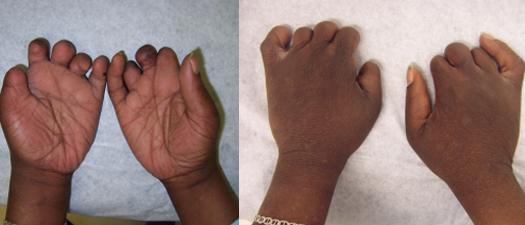
Question 1:
A 45-year-old African American man presented with heart disorders and congenital hand deformities. His previous diagnoses included hypertrophic obstructive cardiomyopathy and mitral regurgitation. Bilateral hand deformities took the form of short nubbin-like fingers with somewhat deformed thumbs. The fifth fingers showed clinodactyly with partially hypoplastic nails. The hand diagnosis was amniotic band syndrome.
NEXT QUESTION »
For the discussion, click here.
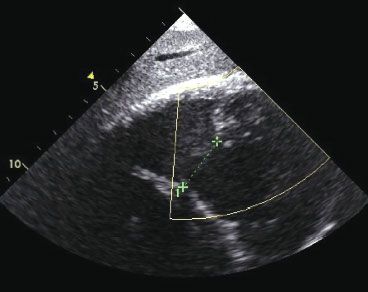
Question 2:
A previously healthy 55-year-old woman complained of fever, weakness, and generalized malaise. Twelve hours after admission, she had hypotension, atrial fibrillation, and worsening respiratory distress; 24 hours after, she had a cardiac arrest. This repeated 2-dimensional transthoracic echocardiogram showed inferior wall hypokinesis, along with a ventricular septal defect in the inferoseptum, a complication of myocarditis.
NEXT QUESTION »
For the discussion, click here.

Question 3:
A 48-year-old African American man sustained a gunshot wound to the face and shoulder and suffered multiple vascular insults, including transection of the proximal right facial artery, intimal injury of the proximal right internal carotid artery, and traumatic false aneurysm of the right proximal external carotid artery. Cardiac catherization and ventriculography led to a diagnosis of Takotsubo cardiomyopathy.
NEXT QUESTION »
For the discussion, click here.
For the answer, click here.
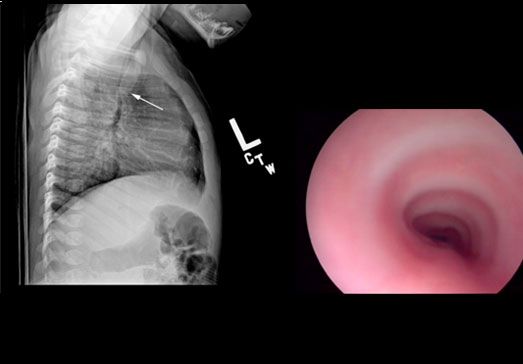
Question 4:
A 3-day-old boy presented with what his mother described as “strange breathing.” He is breast-fed and has no difficulty with choking, swallowing, or reflux during feeds. Esophageal indentation resulting from double aortic arch anomaly may be recognized in plain lateral radiographs (left). Bronchoscopy may demonstrate indentation of the trachea (right). This was a case of double aortic arch in an infant with persistent stridor.
NEXT QUESTION »
For the discussion, click here.
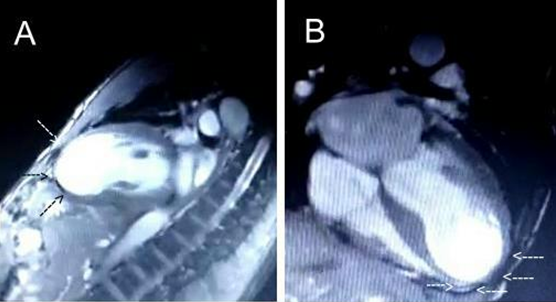
Question 5:
A 53-year-old man with a history of hypertension presented to the ED with intermittent retrosternal chest discomfort. The ECG revealed sinus tachycardia, ST segment elevation, and aVF with associated Q waves. Emergent cardiac catheterization revealed total thrombotic occlusion of the mid left anterior descending coronary artery. Cardiac MRI confirmed an LVA with myocardial tissue hanging in the LV cavity, consistent with intramyocardial dissection of the LV anterior, septal, and apical myocardial walls.
NEXT QUESTION »
For the discussion, click here.
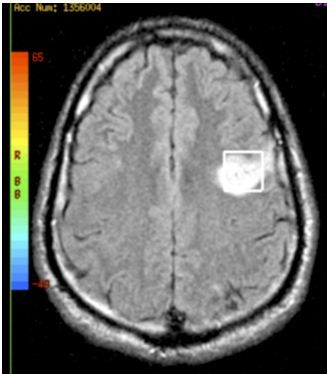
Question 6:
A 42-year-old man presented after multiple episodes of difficulty in speaking. MRI of the brain without contrast suggested an acute infarct in the left frontal supraventricular white matter. Subsequent MRI with contrast indicated a subacute infarct. MRI spectroscopy verified an ischemic infarct. The patient underwent transesophageal echocardiography.
The abnormality it shows appears in about 40% of cryptogenic ischemic strokes.
ANSWER KEY »
For the discussion, click here.
ANSWER KEY:
Question 1. E
Question 2. D
Question 3. B
Question 4. D
Question 5. C
Question 6. A
